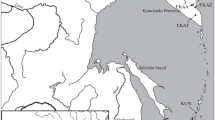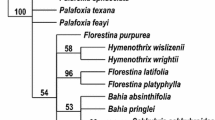Abstract
Thirty species and one variety of Symplocos (Symplocaceae), including all taxa distributed in Japan, were phylogenetically analyzed with DNA sequence data. The evolution of morphological characters is discussed on the basis of the phylogenetic relationships obtained. All species were Asian, except one, S. austromexicana, from Mexico. The nuclear ribosomal internal transcribed spacer (ITS) region and two intergenic spacer regions, between trnL and trnF, and between trnH and psbA of chloroplast DNA were used. The topologies of trees obtained from ITS and the chloroplast intergenic spacers are largely congruent. S. sonoharae, the representative of the subgenus Symplocos in Asia, was sister to all other species. The position of the American species, S. austromexicana, which also belongs to the subgenus Symplocos, was not well resolved. The phylogenetic tree based on combined sequence data largely supports the monophyletic origin of the infrageneric sections proposed earlier. However, the phylogenetic relationship between them is not well resolved, probably due to rapid diversification. The section Palura, a deciduous group, is well defined in the DNA analysis, suggesting its independent status in the genus Symplocos. In spite of their morphological divergence, the three endemic species of the Bonin Islands are monophyletic. The occurrence of curved seeds seems to be homoplastic, scattered over the phylogenetic tree without showing a particular infrageneric relationship.


Similar content being viewed by others
References
Angiosperm Phylogeny Group (2003) An update of the Angiosperm Phylogeny Group classification for the orders and families of flowering plants: APG II. Bot J Linn Soc 141:399–436
Baldwin BG (1993) Molecular phylogenetics of Calycadenia (Compositae) based on ITS sequences of nuclear ribosomal DNA: chromosomal and morphological evolution reexamined. Am J Bot 80:222–238
Baldwin BG, Sanderson MJ, Porter JM, Wojciechowski MF, Campbell CS, Donoghue MJ (1995) The ITS region of nuclear ribosomal DNA: a valuable source of evidence on angiosperm phylogeny. Ann Mo Bot Gard 82:247–277
Barth OM (1979) Pollen morphology of Brazilian Symplocos species (Symplocaceae). Grana 18:99–107
Barth OM (1982) The sporoderm of Brazilian Symplocos species (Symplocaceae). Grana 21:65–69
Bentham G, Hooker JD (1876) Genera Plantarum, vol 2(2). Lovell Reeve, London
Brand A (1901) Symplocaceae. Das Pflanzenreich 6. Wilhelm Engelmann, Leipzig
Bull JJ, Huelsenbeck JP, Cunningham CW, Swofford DL, Waddell PJ (1993) Partitioning and combining data in phylogenetic analysis. Syst Biol 42:384–397
Caris P, Decraene LPR, Smets E, Clickemaillie D (2002) The uncertain systematic position of Symplocos (Symplocaceae): evidence from a floral ontogenetic study. Int J Plant Sci 163:67–74
Chase MW, Soltis DE, Olmstead RG, Morgan D, Les DH, Mishler BD, Duvall MR, Price RA, Hills HG, Qiu Y-L, Kron KA, Rettig JH, Conti E, Palmer JD, Manhart JR, Sytsma KJ, Michaels HJ, Kress WJ, Karol KG, Clark WD, Hedrén M, Gaut BS, Jansen RK, Kim K-J, Wimpee CF, Smith JF, Furnier GR, Strauss SH, Xiang Q-Y, Plunkett GM, Soltis PS, Swensen SM, Williams SE, Gadek PA, Quinn CJ, Eguiarte LE, Golenberg E, Learn GH, Graham Jr. SW, Barrett SCH, Dayanandan S, Albert VA (1993) Phylogenetics of seed plants: an analysis of nucleotide sequences from the plastid gene rbcL. Ann Mo Bot Gard 80:528–580
Clegg MT, Gaut BS, Learn GH Jr., Morton BR (1994) Rates and patterns of chloroplast DNA evolution. Proc Natl Acad Sci USA 91:6795–6801
Cronquist A (1981) An integrated system of classification of flowering plants. Columbia University Press, New York
Felsenstein J (1985) Confidence limits on phylogenies: an approach using the bootstrap. Evolution 39:783–791
Fujii N, Ueda K, Watano Y, Shimizu T (1997) Intraspecific sequence variation of chloroplast DNA in Pedicularis chamissonis Steven (Scrophulariaceae) and geographic structuring of the Japanese “alpine” plants. J Plant Res 110:195–207
Gielly L, Taberlet P (1994) The use of chloroplast DNA to resolve plant phylogenies: noncoding versus rbcL sequences. Mol Biol Evol 11:769–777
Hamilton MB (1999) Four primer pairs for the amplification of chloroplast intergenic regions of intraspecific variation. Mol Ecol 8:521–523
Handel-Mazzetti H, Peter-Stibal E (1943) Eine Revision der chinesischen Arten der Gattung Symplocos Jacq. Beih Bot Centralbl 62B:1–42
Hara H (1948) Enumeratio Spermatophytarum Japonicarum I. Iwanami-shoten, Tokyo
Hasebe M, Iwatsuki K (1990) Adiantum capillus-veneris chloroplast DNA clone bank: as useful heterologous probes in the systematics of the leptosporangiate ferns. Am Fern J 80:20–25
Hatusima S (1936) Miscellaneous notes on the Symplocaceae of Eastern Asia. J Jpn Bot 12:279–283
Meijden R van der (1970) A survey of the pollen morphology of the Indo-Pacific species of Symplocos (Symplocaceae). Pollen Spores 12:513–551
Miers J (1879) On the Symplocaceae. J Linn Soc 17:283–306
Morton CM, Chase MW, Kron KA, Swensen SM (1996) A molecular evaluation of the monophyly of the order Ebenales based upon rbcL sequence data. Syst Bot 21:567–586
Nagamasu H (1989a) Pollen morphology of Japanese Symplocos (Symplocaceae). Bot Mag (Tokyo) 102:149–164
Nagamasu H (1989b) Pollen morphology and relationship of Symplocos tinctoria (L.f.) L’Her. (Symplocaceae). Bot Gaz 150:314–318
Nagamasu H (1993) The Symplocaceae of Japan. Contrib Biol Lab, Kyoto Univ 28:173–260
Nooteboom HP (1975) Revision of the Symplocaceae of the Old World, New Caledonia excepted. Leid Bot Ser, vol 1. Universitaire Pers Leiden
Ohsako T, Ohnishi O (2000) Intra- and interspecific phylogeny of wild Fagopyrum (Polygonaceae) species based on nucleotide sequences of noncoding regions in chloroplast DNA. Am J Bot 87:573–582
Sang T, Crawford DJ, Stuessy TF (1997) Chloroplast DNA phylogeny, reticulate evolution, and biogeography of Paeonia (Paeoniaceae). Am J Bot 84:1120–1136
Savolainen V, Chase MW, Hoot SB, Morton CM, Soltis DE, Clemens B, Fay MF, De Bruijn AY, Sullivan S, Qiu Y-L (2000a) Phylogenetics of flowering plants based on combined analysis of plastid atpB and rbcL gene sequences. Syst Biol 49:306–362
Savolainen V, Fay MF, Albach DC, Backlund A, van der Bank M, Cameron KM, Johnson SA, Lledó MD, Pintaud J-C, Powell M, Sheahan MC, Soltis DE, Soltis PS, Weston P, Whitten WM, Wurdack KJ, Chase MW (2000b) Phylogeny of the eudicots: a nearly complete familial analysis based on rbcL gene sequences. Kew Bull 55:257–309
Slowinski JB, Page RDM (1999) How should species phylogenies be inferred from sequence data? Syst Biol 48:814–825
Small RL, Ryburn JA, Cronn RC, Seelanan T, Wendel JF (1998) The tortoise and the hare: choosing between noncoding plastome and nuclear ADH sequences for phylogeny reconstruction in a recently diverged plant group. Am J Bot 85:1301–1315
Soejima A, Nagamasu H, Ito M, Ono M (1994) Allozyme diversity and the evolution of Symplocos (Symplocaceae) on the Bonin (Ogasawara) Islands. J Plant Res 107:221–228
Soltis DE, Soltis PS, Chase MW, Mort ME, Albach DC, Zanis M, Savolainen V, Hahn WH, Hoot SB, Fay MF, Axtell M, Swensen SM, Prince LM, Kress WJ, Nixon KC, Farris JS (2000) Angiosperm phylogeny inferred from 18S rDNA, rbcL, and atpB sequences. Bot J Linn Soc 133:381–461
Swofford DL (2001) PAUP*: phylogenetic analysis using parsimony (*and other methods). Version 4.0b8. Sinauer, Sunderland, Massachusetts
Taberlet P, Gielly L, Pautou G, Bouvet J (1991) Universal primers for amplification of three non-coding regions of chloroplast DNA. Plant Mol Biol 17:1105–1109
White TJ, Bruns T, Lee S, Taylor J (1990) Amplification and direct sequencing of fungal ribosomal RNA genes for phylogenetics. In: Innis M et al. (eds) PCR protocols: a guide to methods and application. Academic, San Diego, pp 315–322
Wolfe KH, Lie W-H, Sharp PM (1987) Rates of nucleotide substitution vary greatly among plant mitochondrial, chloroplast, and nuclear DNAs. Proc Natl Acad Sci USA 84:9054–9058
Wu Y-F (1987) Symplocaceae. Flora Republicae Popularis Sinicae 60:1–77
Wu RF, Nooteboom HP (1996) Symplocaceae. In: Wu ZY, Raven PH (eds), Flora of China 15:235–252
Yokota Y, Kawata T, Iida Y, Kato A, Tanifuji S (1989) Nucleotide sequences of the 5.8S rRNA gene and internal transcribed spacer regions in carrot and broad bean ribosomal DNA. J Mol Evol 29:294–301
Acknowledgements
We thank Drs. Akiyo Naiki, Shinji Fujii, and Tadashi Kajita for collecting some materials; and Drs. Daisuke Honda and Hiroaki Setoguchi for their kind advice on analyzing sequence data. We are grateful to Minori Yamamoto for providing sequence data. This research was partly supported by a fund from the Showa Seitoku Memorial Foundation (to H.N.).
Author information
Authors and Affiliations
Corresponding author
Rights and permissions
About this article
Cite this article
Soejima, A., Nagamasu, H. Phylogenetic analysis of Asian Symplocos (Symplocaceae) based on nuclear and chloroplast DNA sequences. J Plant Res 117, 199–207 (2004). https://doi.org/10.1007/s10265-004-0151-9
Received:
Accepted:
Published:
Issue Date:
DOI: https://doi.org/10.1007/s10265-004-0151-9




